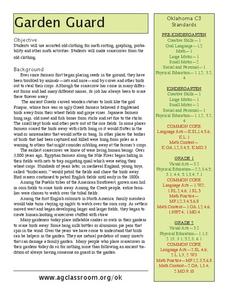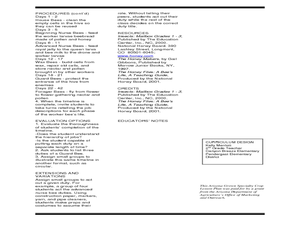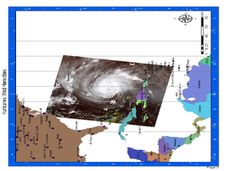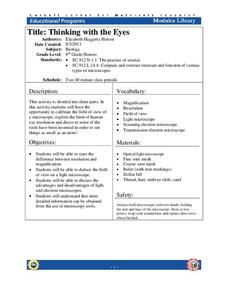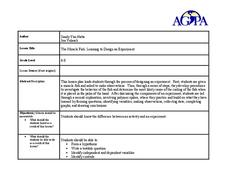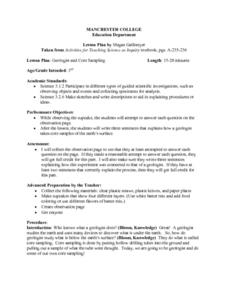Berkshire Museum
Meet a Naturalist: Researching, Writing, Interviewing
Young scholars reach out into the community and learn about different environmental science careers in this inquiry-based instructional activity. Beginning with a short research assignment, children gain background knowledge about...
Curated OER
"What is an Engineer?"
Students describe and draw what an engineer looks like and does. They descrie what they think an engineer does. Students volunteer to read their description to the class. They use their knowledge as well as their classmate;s...
Curated OER
Third Grade Writing Lesson #2/Science Project
Third graders invent a gadget using one or more simple machines. They write a detailed description of that gadget.
Curated OER
Beary O'Mometer Learns About Careers In Meteorology
Students explore the field of meteorology. In this meteorology instructional activity, students explore weather-related careers as they research the field of study as well as various weather concepts. Students interview meteorologists,...
Curated OER
Eyeing the Next Einstein
Students complete a KWL chart on Albert Einstein. After they read an article, they discover more about his iconic status and how future scientists view him. In groups, they create trading cards about Einstein and another scientist of...
American Museum of Natural History
Fossils
Sixteen slides showcase an average day on the job for a paleontologist, Ross MacPhee. Engaging images include world maps and real-world photographs from an archeological dig in Antarctica. A brief description accompanies each slide.
Curated OER
Garden Guard
Students read about the history of farming with the use of scarecrows and then sort clothing, build scarecrows, write descriptions, and more. In this scarecrows lesson plan, students also play a game called Garden Tag.
Curated OER
How Busy Are Bees?
Students research the jobs of bees. In this timeline lesson plan, students map out each of the six different jobs a worker bee does in its lifetime. They create a timeline and then retell the job descriptions.
Curated OER
Help Wanted!
In this plant part worksheet, learners read the classified advertisements and match each of the plant parts to the job descriptions provided.
Curated OER
Hazardous Products Substitutes
Third graders write a hazardous products substitutes recipe book. In this Science lesson plan, 3rd graders identify words and symbols that indicate hazardous substances. Students investigate safe substitutes and write a recipe book to...
Chicago Botanic Garden
Reflecting on What I Learned About Climate Change
After three eye-opening lessons about our environment, scholars revisit a 10-question survey, reflect on their new-found knowledge, and take action by writing to a representative or creating a public service announcement about...
Omaha Zoo
I Like to Move It
What do lemurs do best? They move! Lemurs like to jump, run, hop, and climb and it's your class's job to document seven fun lemur behaviors. The class starts by discussing why lemurs are considered primates, and then they isolate seven...
Curated OER
Career Exploration
Students investigate possible career paths in forestry they may pursue. In this vocational activity, students discover the many careers possible in the world of science by researching teacher approved career websites on the...
Curated OER
Science: Invent a Gadget
Third graders invent gadgets using simple machine principles. Once they have assembled graphic organizers containing information about their invention, they draw diagrams and explain how their gadget works. Lastly, 3rd graders write...
Curated OER
Hurricane Winds: A Spatial Hierarchy of Processes at Different Scales
In this earth science lesson, students study a satellite image of hurricane Isabel and write answers to 5 questions that follow. They match predictions to the map locations.
Curated OER
Whst Makes You Tick?
Eleventh graders explore the major organs of the circulatory system. In this circulatory system lesson, 11th graders create, identify and describe parts of the system. Students view a list of major organs and predict what their job is....
Cornell University
Thinking with the Eyes
Objects are larger (or smaller) than they appear! Scholars use a laboratory investigation to explore the difference between resolution and magnification. The activity allows them to calculate the size of the field of view of their light...
Curated OER
Oobleck
First graders explore Oobleck. They manipulate and observe the properties of Oobleck. Students discuss the differences between solids and liquids. They investigate Oobleck. Students write a sentence describing what they observed about...
Curated OER
The Miracle Fish: Learning to Design an Experiment
Young scholars develop procedures to explore the behavior of fish. In this scientific experiment lesson students from a hypothesis, write a question, identify different variables and controls in their experiment.
Curated OER
Human Body Quest
In this biology worksheet, students describe and name their organ system selected and its major functions. Then they create a diagram of their body system with the major parts and organs labeled. Students also write facts about their...
Curated OER
Geologist and Core Sampling
Third graders observe a cupcake and attempt to answer each question on the observation page. They write three sentences that explains how a geologist takes core samples of the earth's surface. Students make sketches and write...
Curated OER
What Do These People Know That I Don't Know?
Students research career areas within the field of oceanography. They read interviews of people who work in these fields and discuss how the fields are similar. They write a paragraph or more telling what career choice sounded most...
Curated OER
X Is For Wonderment
Students engage in a lesson that is concerned with the "X" chromosome and how ti is part of genetics with the use of Punnett squares. They use this tool in order to predict future genetic outcomes while focusing upon specific questions.
Curated OER
Dig It Up
Students participate in an archaeological excavation to determine how archeologists make inferences about various cultures. They reconstruct the site using layers of drawings. They discuss the kinds of information they learned.






